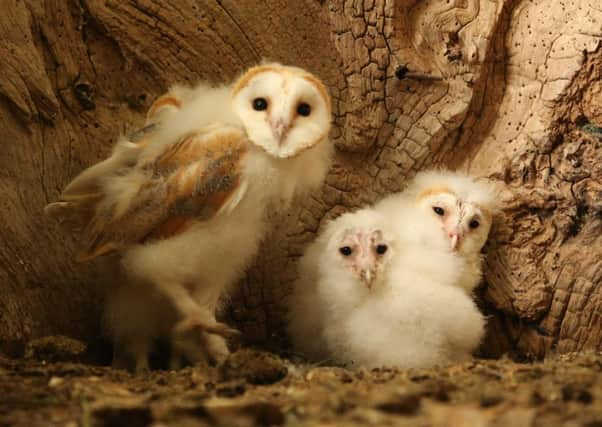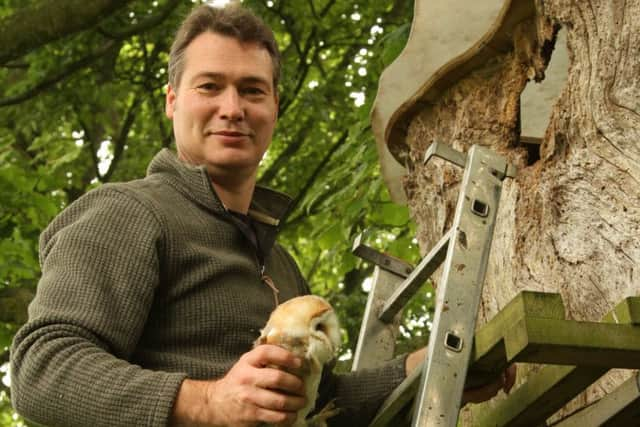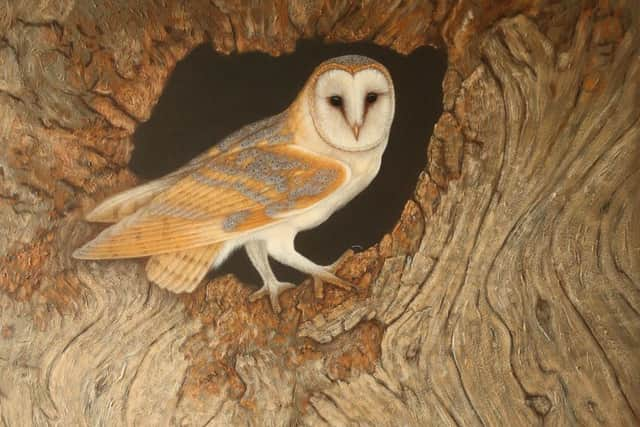Barn owls become foster parents to pair of chicks


This year, I have successfully re-homed kestrel, barn owl and tawny owl chicks that have been found and handed in to me, putting them back into wild nests. Now wildlife rehabilitation centres have even begun to bring me rescued chicks, which I ‘foster’ onto unsuspecting parent birds. And I’ve been sharing my findings with the World Owl Trust of which I am a patron in the hope that it can help their conservation efforts abroad.
Last year I put the parenting skills of a pair of tawny owls to the test by persuading them to take on six extra owlets: taking their brood up to 10. I supported this large brood by offering food to supplement their diet until the chicks became independent.
Advertisement
Hide AdAdvertisement
Hide AdLast month I pushed the boundaries by persuading a pair of barn owls to accept two foster barn owl chicks before their own eggs had hatched. A farmer had found these chicks when emptying a barn of straw. They were less than a week old and were very frail. They needed to be kept warm so I put them on a heat mat in a box in my porch while I decided what to do with them.


I’ve raised owlets this size before, feeding them every few hours and trying to release them back into the wild when they’re fully grown. But the young chick can become ‘imprinted’ on you, mistaking you for its real mother. It causes them real difficulty when they try to make their own way in the wild as they’re instinctively drawn to humans. It makes more sense to get a wild owl to raise them if you can.
In my last column I wrote about a pair of barn owls living close to my gallery that’d won a battle with a kestrel over a nesting site. I already had this nesting site wired with a camera which could relay live video footage to a screen in my studio, so I decided to foster the barn owl chicks onto this pair so I could see how the female took to the new chicks.
I’ve put chicks into a barn owl nest before but always when the bird’s own chicks had hatched and were well-grown. This pair was still incubating eggs in a nest box in a sycamore tree.
Advertisement
Hide AdAdvertisement
Hide AdThat evening I propped my ladder against the tree. The female flew out as I climbed with the chicks balanced in my left hand. With the box vacated I placed the two chicks next to the still warm eggs. I left quickly and headed home, keen to see on screen how these new chicks would be received.


I was surprised to see the female owl was already inside the box when I got back. She was looking down at the chicks as if to say, ‘Cor blimey I’ve only been gone a second’. For a horrible moment I wondered if she was going to brood them or eat them. Then she touched each chick with her beak and started to try and work out how she was going to get these helpless wriggling white blobs underneath her to brood.
It was important that these young chicks survived as 2015 has been a very disappointing year so far for breeding barn owls. Their success is closely linked to the availability of their main prey, field voles. Vole numbers fluctuate along a four to five year cycle which can be affected by the weather.
Last year’s relatively mild winter, followed by a great summer, brought a ‘boom’ year for voles and it proved to be the best year on record for breeding barn owls, with many pairs rearing two clutches of chicks - ‘double brooding.’ But this year there’s been so few voles that females haven’t been able to eat enough to get into healthy breeding condition. When they’re below a certain weight they don’t bother to breed.
Advertisement
Hide AdAdvertisement
Hide AdI’d rung the female the year before with a colleague so I knew she was a new parent and these two extra owlets were her first ever chicks. She didn’t seem to know how to brood them and where to put her long sharp talons. She kept lifting one foot and then the other and clenched her claws into a tight fist in an attempt to keep the chicks safe but she stood on them in the process. She pecked at her own feet in frustration, but after lots of fidgeting, she was sitting on her new brood.
Just before midnight the male arrived. Whenever he comes into the nest box he briefly greets her and then tries to mate her. Normally when he does this, even if she is incubating the eggs, she bows her head in submission. But this time she looked him straight in the eye and pecked at him in disbelief. He took a step back in confusion before stepping forward to try again. But again she rebuffed his advances, this time standing up with her wings out and pushing him around the large nest box, pecking him all the while. She forced him into the far corner and made him stay there while she returned to tend to her chicks.
She sat back carefully onto her cherished owlets, a look of complete contentment writ large across her face and then glanced up disdainfully to check that the male was keeping his distance. He watched on forlornly from the sidelines and shuffled around the edges of the box.
It was fascinating to watch but even better to see that she had taken to her role as surrogate with such dedication.
Advertisement
Hide AdAdvertisement
Hide AdThe next morning I watched as she fed the chicks in turn, each chick tucked neatly under a wing.
A week later, the barn owl’s own eggs hatched.
There was a sizeable difference between the largest and smallest chick in the nest, but this didn’t overly concern me. A barn owl usually lays one egg every three days. So if they lay six, there will be 18 days between the oldest and youngest chick.
This, however, can present a very nasty problem. The chicks grow so fast that the largest is big enough to swallow the youngest one whole so I’m putting out extra food for this artificially expanded family in the hope these four chicks will make it to fledging time.
I hope this wild surrogacy technique I’ve honed near my home in Thixendale can be used in conservation projects around the world.
For details about Robert Fuller’s exhibitions, visit www.robertefuller.com